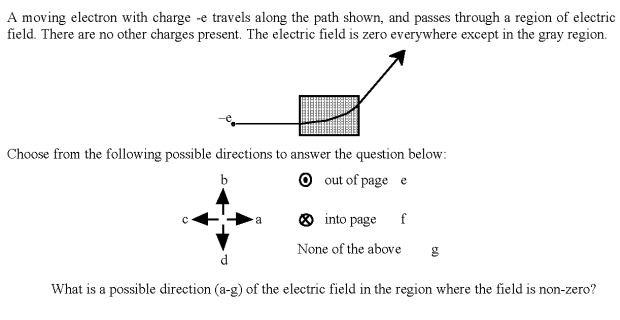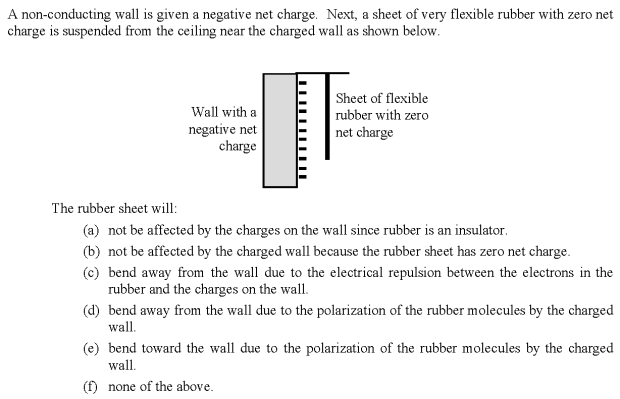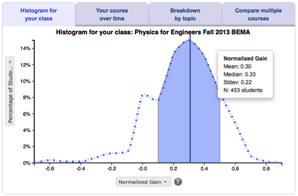Developed by Ruth Chabay and Bruce Sherwood
| Purpose | To assess students’ qualitative understanding of basic concepts in electricity and magnetism. |
|---|---|
| Format | Pre/post, Multiple-choice |
| Duration | 45 min |
| Focus | Electricity / Magnetism Content knowledge (circuits, electrostatics, magnetic fields and forces) |
| Level | Upper-level, Intro college |
Sample questions from the BEMA:

BEMA Implementation and Troubleshooting Guide
Everything you need to know about implementing the BEMA in your class.
Login or register to download the implementation guide.
more details
This is the highest level of research validation, corresponding to all seven of the validation categories below.
Research Validation Summary
Based on Research Into:
- Student thinking
Studied Using:
- Student interviews
- Expert review
- Appropriate statistical analysis
Research Conducted:
- At multiple institutions
- By multiple research groups
- Peer-reviewed publication
The multiple-choice questions on the BEMA were developed using student responses to open-ended versions of the questions and expert review. Appropriate statistical analyses were conducted and the difficulty of the items was found to be in the optimal range, most individual items on the BEMA are able to satisfactorily distinguish students who know the material well from those who don’t and almost all were found to be consistent with the rest of the test. The total scores on the BEMA were found to be broadly distributed over the possible range, meaning that the BEMA as a whole has can discriminate well between students. The BEMA has been used to compare the effectiveness of different teaching methods and the results published in peer-reviewed publications. It has been administered at many different institutions.
References
- R. Chabay and B. Sherwood, Restructuring the introductory electricity and magnetism course, Am. J. Phys. 74 (4), 329 (2006).
- R. Chabay and B. Sherwood, Bringing atoms into first-year physics, Am. J. Phys. 67 (12), 1045 (1999).
- R. Chabay and B. Sherwood, Matter & Interactions, in Research-Based Reform of University Physics, edited by E. Redish and P. Cooney, (American Association of Physics Teachers, College Park, 2007), Vol. 1.
- S. Chasteen, Teasing out the effect of tutorials via multiple regression, presented at the Physics Education Research Conference 2011, Omaha, Nebraska, 2011.
- S. Chasteen, R. Pepper, M. Caballero, S. Pollock, and K. Perkins, Colorado Upper-Division Electrostatics diagnostic: A conceptual assessment for the junior level, Phys. Rev. ST Phys. Educ. Res. 8 (2), 020108 (2012).
- S. Chasteen and S. Pollock, Transforming Upper-Division Electricity and Magnetism, presented at the Physics Education Research Conference 2008, Edmonton, Canada, 2008.
- S. Chasteen, S. Pollock, R. Pepper, and K. Perkins, Transforming the junior level: Outcomes from instruction and research in E&M, Phys. Rev. ST Phys. Educ. Res. 8 (2), 020107 (2012).
- C. Crouch and K. Heller, Teaching physics to life science students - Examining the role of biological context, presented at the Physics Education Research Conference 2011, Omaha, Nebraska, 2011.
- C. Crouch, P. Wisittanawat, and K. Renninger, Initial Interest, Goals, and Changes in CLASS Scores in Introductory Physics for Life Sciences, presented at the Physics Education Research Conference 2013, Portland, OR, 2013.
- L. Ding, Applying Rasch theory to evaluate the construct validity of brief electricity and magnetism assessment, presented at the Physics Education Research Conference 2011, Omaha, Nebraska, 2011.
- L. Ding, Seeking missing pieces in science concept assessments: Reevaluating the Brief Electricity and Magnetism Assessment through Rasch analysis, Phys. Rev. ST Phys. Educ. Res. 10 (1), 010105 (2014).
- L. Ding, R. Chabay, B. Sherwood, and R. Beichner, Evaluating an electricity and magnetism assessment tool: Brief electricity and magnetism assessment, Phys. Rev. ST Phys. Educ. Res. 2 (1), 7 (2006).
- P. Eaton, B. Frank, K. Johnson, and S. Willoughby, Comparing exploratory factor models of the Brief Electricity and Magnetism Assessment and the Conceptual Survey of Electricity and Magnetism, Phys. Rev. Phys. Educ. Res. 15 (2), 020133 (2019).
- P. Eaton, K. Johnson, B. Frank, and S. Willoughby, Classical test theory and item response theory comparison of the brief electricity and magnetism assessment and the conceptual survey of electricity and magnetism, Phys. Rev. Phys. Educ. Res. 15 (1), 010102 (2019).
- J. Hansen and J. Stewart, Multidimensional item response theory and the Brief Electricity and Magnetism Assessment, Phys. Rev. Phys. Educ. Res. 17 (2), 020139 (2021).
- C. Keller, N. Finkelstein, K. Perkins, and S. Pollock, Assessing the Effectiveness of a Computer Simulation in Introductory Undergraduate Environments, presented at the Physics Education Research Conference 2006, Syracuse, New York, 2006.
- C. Keller, N. Finkelstein, K. Perkins, and S. Pollock, Assessing the Effectiveness of a Computer Simulation in Conjunction with Tutorials in Introductory Physics in Undergraduate Physics Recitations, presented at the Physics Education Research Conference 2005, Salt Lake City, Utah, 2005.
- M. Kohlmyer, M. Caballero, R. Catrambone, R. Chabay, L. Ding, M. Haugan, M. Marr, B. Sherwood, and M. Schatz, Tale of two curricula: The performance of 2000 students in introductory electromagnetism, Phys. Rev. ST Phys. Educ. Res. 5 (2), 020105 (2009).
- L. Kost-Smith, S. Pollock, and N. Finkelstein, Gender disparities in second-semester college physics: The incremental effects of a "smog of bias", Phys. Rev. ST Phys. Educ. Res. 6 (2), 020112 (2010).
- S. Pollock, Comparing Student Learning with Multiple Research-Based Conceptual Surveys: CSEM and BEMA, presented at the Physics Education Research Conference 2008, Edmonton, Canada, 2008.
- S. Pollock, Transferring Transformations: Learning Gains, Student Attitudes, and the Impacts of Multiple Instructors in Large Lecture Courses, presented at the Physics Education Research Conference 2005, Salt Lake City, Utah, 2005.
- S. Pollock, A Longitudinal Study of the Impact of Curriculum on Conceptual Understanding in E&M, presented at the Physics Education Research Conference 2007, Greensboro, NC, 2007.
- S. Pollock, Longitudinal study of student conceptual understanding in electricity and magnetism, Phys. Rev. ST Phys. Educ. Res. 5 (2), 020110 (2009).
- S. Pollock and S. Chasteen, Longer term impacts of transformed courses on student conceptual understanding of E&M, presented at the Physics Education Research Conference 2009, Ann Arbor, Michigan, 2009.
- S. Pollock and N. Finkelstein, Impacts of curricular change: Implications from 8 years of data in introductory physics, presented at the Physics Education Research Conference 2012, Philadelphia, PA, 2012.
- S. Pollock and N. Finkelstein, Sustaining Change: Instructor Effects in Transformed Large Lecture Courses, presented at the Physics Education Research Conference 2006, Syracuse, New York, 2006.
- S. Pollock and N. Finkelstein, Sustaining educational reforms in introductory physics, Phys. Rev. ST Phys. Educ. Res. 4 (1), 010110 (2008).
- Y. Xiao, J. Fritchman, J. Bao, Y. Nie, J. Han, J. Xiong, H. Xiao, and L. Bao, Linking and comparing short and full-length concept inventories of electricity and magnetism using item response theory, Phys. Rev. Phys. Educ. Res. 15 (2), 020149 (2019).
PhysPort provides translations of assessments as a service to our users, but does not endorse the accuracy or validity of translations. Assessments validated for one language and culture may not be valid for other languages and cultures.
If you know of a translation that we don't have yet, or if you would like to translate this assessment, please contact us!

Login or register to download the answer key and an excel scoring and analysis tool for this assessment.
Score the BEMA on the PhysPort Data Explorer
With one click, you get a comprehensive analysis of your results. You can:
- Examine your most recent results
- Chart your progress over time
- Breakdown any assessment by question or cluster
- Compare between courses
| Typical Results | |||||||||||||||
|---|---|---|---|---|---|---|---|---|---|---|---|---|---|---|---|
Typical results from study by Eaton et al., 2019 who analyzed BEMA and CSEM data obtained from PhysPort's Data Explorer.
|
The latest version of the BEMA, released in 1997, is version 1.






